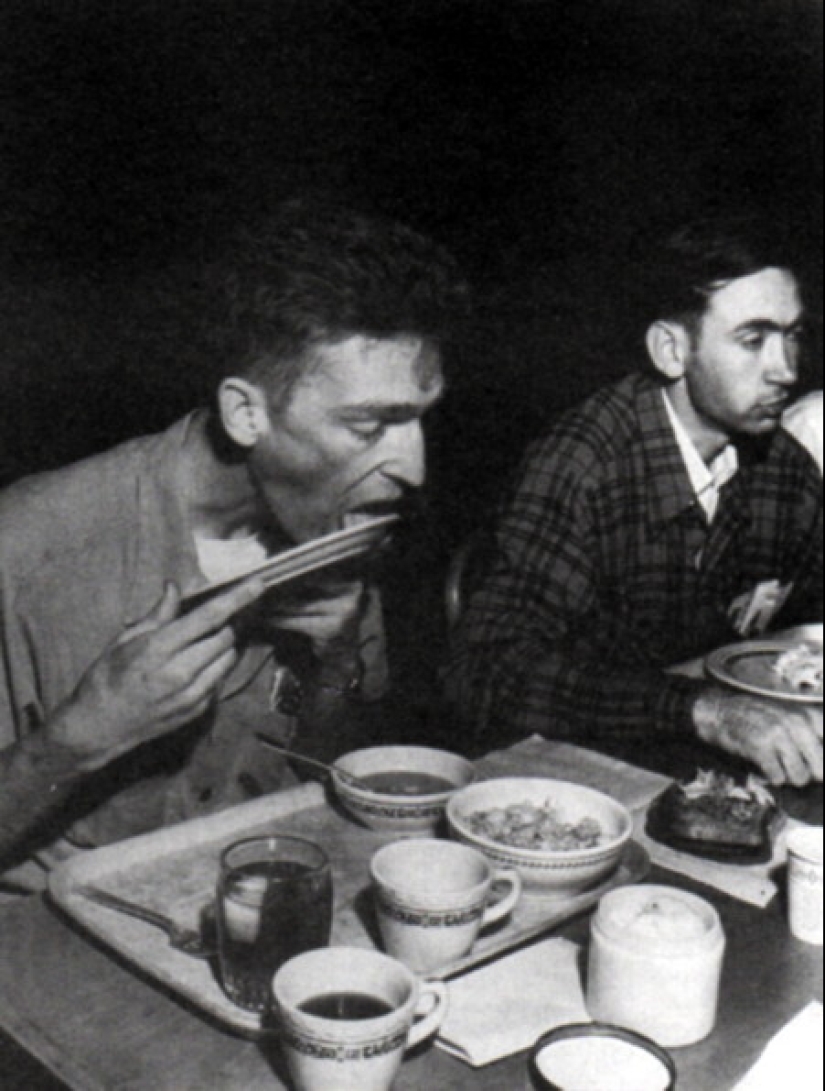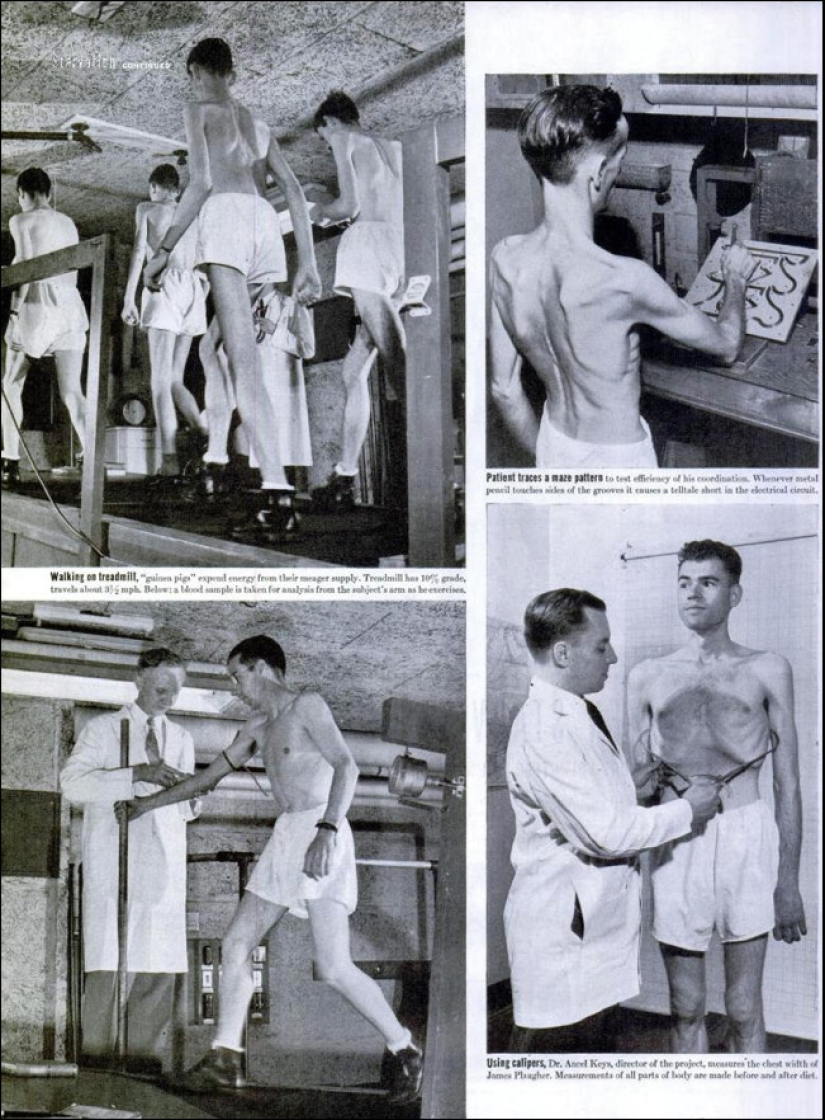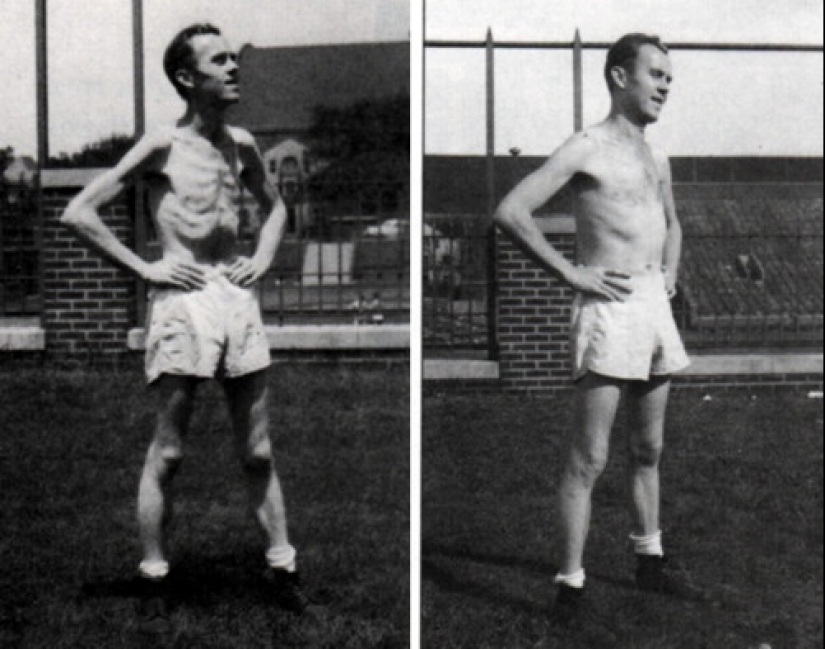Voluntary starvation: how the 1944 Minnesota Experiment ended
During the Second World War, people, surprisingly enough, did not die en masse from bullets and shells. They were facing one of the most terrible fates imaginable—starvation. The reason for this was an acute shortage of food due to destroyed crops and disrupted food supply lines.
During the siege of Leningrad, more than a thousand people died daily from lack of food. However, famine in those days was observed in the most unexpected places — for example, in the city of Minneapolis (Minnesota). In 1944, 36 young men took part in a "hungry" experiment conducted by Dr. Ancel Keys.



Ansel Keys was the head of the Laboratory of Physiological Hygiene at the University of Minnesota. He has already achieved some fame by creating K‑rations dry rations for American servicemen.
Ansel Benjamin Keys, born in Colorado, USA, was an American physiologist who studied the effects of diet on health. In particular, he suggested that fat saturated with fatty acids entering the body with food causes cardiovascular heart disease and should be avoided. In addition to publishing the book "The Biology of Human Hunger", which still remains the only source on this topic, Keys also studied the origin of cardiovascular diseases and invented two diets - the K-diet (dry rations for soldiers of the Second World War, containing products for three meals: breakfast, lunch and dinner) and the Mediterranean diet, which he and his wife successfully promoted. In short, science, diet and health were the main topics of his professional and personal life.
The idea to conduct a "hungry" experiment arose due to Kisa's increased interest in nutrition issues. Despite the fact that millions of people suffered from hunger in Europe, there were very few doctors in the world who could really help them overcome the effects of exhaustion after the end of the war, since at that time there was practically no scientific information on this problem. Kis convinced the military that his research would be of great benefit: obtaining practical and effective rehabilitation methods would improve the health of the population and establish democracy in post-war Europe.

Group photo of participants of the Minnesota experiment
Ansel Keys' research plan was very simple: first, bring the subjects to a state close to exhaustion, and then return them to a normal diet.
In order for everything to go in a controlled, scientific manner, the "hungry" experiment, which was supposed to last a year, was divided into three parts: the first three months — the control period (the usual diet, the same for all subjects), the next six months - fasting, the last three months - rehabilitation.
Participants in the Kisa experiment were volunteers from among conscientious objectors - young people who did not want to do military service for ethical or religious reasons. Many of them were members of "historical peace churches" (Quakers, Mennonites and "brethren").
Kisa's assistants prepared special pamphlets for these young people that appealed to their idealism. They depicted three small children looking sadly at empty plates. The inscription at the bottom read: "Are you ready to starve in order to feed them better?"

The trick worked. Kis did not promise the volunteers money and warned them about the serious consequences of prolonged fasting, however, despite this, he received more than 400 applications to participate in the experiment. Many refuseniks were forced to do unskilled work, such as repairing roads in rural areas, and the experiment gave them a chance to do something for the benefit of all mankind.
Kees, having carefully studied each of the applications received for participation in the experiment, selected 36 young men who seemed to him strong enough, strong and hardy enough to withstand a long period of fasting.
The subjects arrived in Minneapolis in November 1944. They were placed in a large common room, which was located under the university football stadium, where Keys temporarily moved his laboratory.
For the next twelve weeks — the control period — the Cis was engaged in standardization of the diet of the subjects. They all ate the same and consumed 3,200 calories a day. At the same time, the Cis, through various tests, collected information about the health status of each of the participants in the experiment on parameters such as heart size, blood volume, hearing, vision, physical shape, body fat and even the number of sperm in the sperm. Young people, at the request of Kisa, led an active lifestyle, worked in the laboratory and walked at least 22 kilometers a week.

Sam Legg before the experiment (left) and during it (right)
On February 12, 1945, Keys drastically reduced the subjects' diet to 1,570 calories per day. The stage of starvation has begun. He carefully controlled the amount of food that the young people consumed. They ate only twice a day. The dishes were prepared mainly from foods rich in carbohydrates. The participants of the experiment received less protein. The emphasis was on potatoes, cabbage, pasta and wholemeal bread - what Europeans mainly ate during the Second World War. The subjects, despite the decrease in the number of calories consumed, continued to lead an active lifestyle, including working in the laboratory and walking.
The consequences of changes in nutrition were not long in coming. Soon, young men began to experience a decline in strength and energy. They began to complain of lethargy and constant fatigue. Keys noted that their strength indicators decreased by 21 percent.
Further, mental apathy began to be traced in all participants of the experiment. Previously, young people hotly discussed topics such as politics, romantic relationships and sex, and now even they have lost all meaning for them. Food was what worried them the most. Some men began to constantly read cookbooks, looking at the appetizing pictures in them almost with pornographic obsession.
The subjects often showed irritability and aggressiveness if the food was not served on time or they had to wait in line for a long time in the dining room. The dishes were the most ordinary, but the young people savored every spoonful. Sometimes they added water to the food to increase its volume and deceive the stomach.

In the intervals between two meals, Kis allowed the participants of the experiment to chew gum for an unlimited time, drink as much as they wanted, water and black coffee. He noticed that young people chewed as many as 40 packs of chewing gum a day and drank 15 cups of coffee.
The depth of the psychological stress experienced by the participants of the experiment struck Kisa. Over time, they began to eat food without his knowledge. In the end, Kisu had to assign people to all the subjects who constantly watched their every move.

24-year-old Franklin Watkins was psychologically worse than others going through a period of starvation. He had disturbing dreams in which he committed an act of cannibalism by eating the flesh of an elderly man. During trips to the city (before supervisors were assigned to the subjects) Watkins bought milkshakes and ice cream. Ansel Keys found out about this some time later and decided to have a one-on-one conversation with the subject. The young man just burst into tears when talking to him. Then he had a fit of anger, during which he threatened to kill Kitty, and then himself.

Keys was forced to send Watkins to the psychiatric department of the university Hospital. A few days later, he was released, as he returned to his normal diet, immediately began to return to normal. The breakdown occurred in a young man just a couple of weeks after the transition to the fasting stage.
Subsequently, Kisu had to exclude another man from the number of participants in the experiment for the same reason.

All participants in the experiment initially had a normal body weight. During the control period, their average weight was 70 kilograms. After the start of starvation, they began to lose weight rapidly, turning into walking skeletons. Ansel Keys carefully analyzed and documented all the physiological changes that were happening to them.
He found that the average heart rate in young people dropped sharply: before fasting it was 55 beats per minute, and after that it was only 35. The body switched to an "energy-saving mode" due to a calorie deficit, slowing down the metabolism. Their stool frequency was once a week. The volume of blood decreased by 10 percent, the size of the heart also decreased.
Apparently, due to the consumption of a large amount of water, young people had swelling of the face, knees and ankles. The skin of some of them has become very rough. Other symptoms experienced by the participants in the experiment included dizziness, muscle pain, decreased coordination, ringing in the ears and unnatural whiteness of the eyeballs due to narrowing of blood vessels.

From a male point of view, the most uncomfortable physiological change was the absence of subcutaneous fat. The participants of the experiment could not sit on a hard surface for a long time, because it gave them terrible discomfort. Moreover, they were constantly cold.
Keys also noticed that young people's eyesight remained normal after a long period of fasting, and their hearing, surprisingly, improved significantly.
Despite all the physiological changes, the subjects did not consider themselves too thin. On the contrary, it began to seem to them that it was the other participants in the experiment who were fat, and they were normal. Such thoughts are typical for patients with anorexia.

Dan Miller during the fasting period and after
After six months of fasting, the subjects lost almost a quarter of their body weight. Their average weight was 52 kilograms.
The rehabilitation period began on July 29, 1945. Kis divided all the subjects into four subgroups, which now began to receive 400, 800, 1200 or 1600 calories more than during fasting. He did this in order to determine the optimal amount of calories that should be consumed during the recovery period.
Some participants were given vitamin and protein supplements by the Cis to see how this would affect rehabilitation. After a few weeks, it became clear that they were absolutely useless. Moreover, the men who consumed the least amount of calories did not recover at all. In the end, Keys came to the conclusion that in order to return the body to normal, you should consume about 4,000 calories per day.
The "hungry" experiment ended on October 20, 1945. Young people could now eat whatever they wanted. Some of them were asked by Keys to stay in the laboratory for another couple of months in order to observe them during the "period of unlimited rehabilitation". He noticed that young people began to consume on average more than 5,000 calories a day. For several months, they all declared that they could not satisfy their hunger, no matter how much they ate.
Ansel Keys published a full report on the experiment and its results in 1950. It was a huge two-volume work called "The Biology of human hunger." To this day, it remains the most comprehensive scientific study of the effects of hunger.
In the Kisa report, much attention is paid to how much our physical and mental state changes under the influence of lack of food. Nevertheless, the results of the experiment also showed that hunger does not have any significant and long-term negative impact on human health.
Recent articles

No wonder long hair has been considered a woman's adornment for many centuries. Girls with luxurious curls attract attention and ...

And now the artists have fans who regularly visit their concerts, stand for hours in line for a selfie or an autograph and know by ...

Sometimes a single incident can completely change a person's life, turning it into a legend whose reality is hard to believe. ...